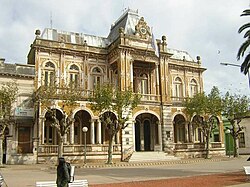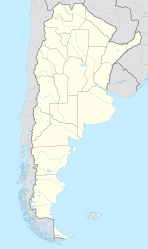Victoria, Entre Ríos
| Victoria | |
|---|---|
| City | |

Victoria's City Hall
|
|
| Location of Victoria in Argentina | |
| Coordinates: 32°37′S 60°10′W / 32.617°S 60.167°WCoordinates: 32°37′S 60°10′W / 32.617°S 60.167°W | |
| Country | Argentina |
| Province | Entre Ríos |
| Department | Victoria Department |
| Government | |
| • Intendente | Ruben D. Garcilazo (Justicialist Party) |
| Elevation | 64 m (210 ft) |
| Population (2012) | |
| • Total | 32,411 |
| Demonym(s) | victoriense |
| Time zone | ART (UTC-3) |
| CPA base | E3153 |
| Dialing code | +54 3436 |
| Website | Official website |
Victoria is a city located in the southwestern part of the province of Entre Ríos, Argentina. It is located on the eastern shore of the Paraná River, opposite Rosario, Santa Fe, to which it has been connected since 2003 by the Rosario-Victoria Bridge (which spans almost 60 km over the flood plain of the Paraná Delta).
The site of a 1750 defeat of a native uprising and an 1810 oratory to the Virgin of Aranzazú, a Marian apparition and the city's patron saint, Cerro La Matanza was granted Village status by the Provincial Legislature, in 1826. An 1829 edict renamed the hamlet Victoria. The church (started in 1872) is dedicated to this patron. Designated a "city" in 1851, Victoria also features an abbey (Abadía Los Monjes del Niño Dios), founded by Benedictine monks who arrived in 1899.
The Victoria region is at the core of the fishing industry of commercially important species like sábalo (Prochilodus lineatus) and surubí (Pseudoplatystoma spp.); it produces 95% of the annual 27,000 tonnes of sábalo captured in the province. Concerns about over-exploitation of this resource have been raised lately.
The city has a beach resort, and the river at this point is appropriate for the practice of sports such as kayak sailing and windsurf. The municipality claims jurisdiction over 3,700 km² of islands and islets on the Paraná. Several fishing areas are reserved for sports purposes, while others are protected.
...
Wikipedia

